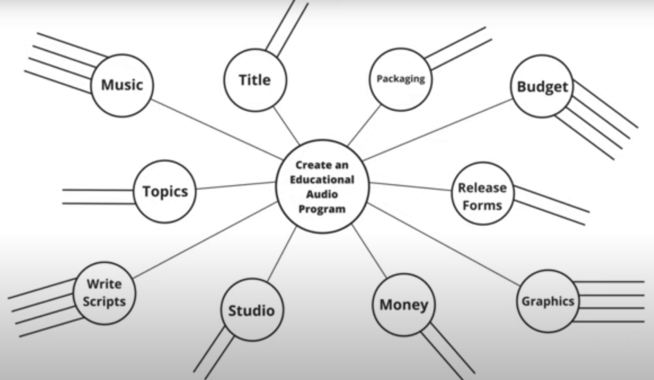Mind mapping is a powerful way to create a dynamic to-do list. It’s simple to learn and use, too.
That’s why today, I want to discuss how you can leverage the power of mind mapping to achieve your goals and succeed at anything you choose!
Why Try Mind Mapping
Are you ever daunted by the question of where to begin? You’ve set a goal and know it’s the right path for you to take, but the steps you need to take are not fully clear and in no particular order.
Where should you start when everything seems equally important? You could certainly talk to others who have pursued the same goal, buy a how-to book, or begin to learn the skills you think you need.
I’ve been in that spot before and know exactly what you might be feeling.
I’ve found one technique that helps me carve out the key steps to take and get all that thinking out of my head and other paper. I’ve created books and many products by using mind mapping.
What is Mind Mapping?
Tony Buzan, an English writer and consultant, created the mind mapping technique. He was inspired by Da Vinci and Einstein among others.
Mind mapping creates a visual display of information. It details the relationships between different components and can be drawn by hand or by using software programs.
By using mind mapping, you can take that core goal you want to achieve and flesh out answers to key questions:
- What information do you need to collect?
- Who will you need to talk to? What are the small steps you need to take?
- How much money will you need?
- What deadlines do I need to meet?
It all starts with a central topic, idea, or goal drawn in the center of the page.
Chunking it Down
My first educational program started with an idea and a vision of what I wanted to achieve. It did not emerge fully formed, however.
Mind mapping allowed me to “chunk down” by getting started on the work I knew needed to be done. I was able to break down that very large goal into the individual tasks that would need to be completed.
It started with that big idea in the center of the page: “Create an Educational Audio Program.”
Next, I created offshoots that included audience, packaging, title, music, money, budget, graphics, studio, topics and even props.
From there, action items emerged for each offshoot. My plan was finally, clearly in front of me and I could begin working on the most urgent chunks.

With your map in hand, you can begin to tackle the project, one chunk at a time. Here is a suggested path forward:
1. Create a Daily Schedule
Convert your to-do items into daily scheduled tasks and be sure to do what’s needed to keep yourself on track.
2. Focus on What Matters
Determine which tasks are the most important first. Often these are not the easiest or most pleasant tasks, but when you complete them, especially early in the day, you can give yourself a big pat on the back.
3. Plan Your Day
Plan each day the night before. Spend a few minutes creating that to-do list and visualizing how you want the day to go.
4. Use the Achievers Focusing System
This approach, developed by Les Hewitt, gives you a one-page guide to listing your goals and charting your progress.
Mind Map Components
At its core, a mind map has three simple components.
1. A Center Circle
This is where you put your goal.
2. Outside Circles
Divide your goal into major tasks and categories. These are the areas you’ll need to address in order to achieve the central goal.
3. Spokes
Draw spokes poking out from each outside circle. This is where you lay out the tasks you need to complete. You can break these down even further with action items to be completed.
How Mind Mapping Works
Mind mapping works because it taps into all the knowledge, instincts and insights that are stored in our gray matter. One of the reasons mind mapping is so effective because it gives you a clear pathway.
Benefits of Mind Mapping
Mind mapping gives you the path ahead laid out in broad daylight. It also creates structure.
Our minds can bombard us with lots of information that often seems disjointed. The mind map structures and stores vast amounts of information, shows relationships and gives you a 30,000-foot view of the issue.
Boosts Creativity
Creating the mind map stimulates your brain and gets your creative juices flowing.
A mind map is also a great tool to show your ideas to others and ask for feedback and insights.
Boosts Memory
With images, colors and mapped relationships in place, you’ll have far better recall than jotting notes alone.
Boosts Productivity
Finally, you’ll be more productive when you use a mind map. You and others will understand the concepts and needs in clear detail. You’ll learn faster and save time by focusing on what you’ve mapped.
We all want to meet our goals. Using the mind mapping technique is an effective way to break your big tasks into manageable ones and achieve success.
I’d like to hear your thoughts after reading this blog. Have you ever tried mind mapping for a project? How did it go?
If you feel inspired, please leave a comment below with your answer. I’d love to read what you have to say! Thank you for reading – and remember, nothing in your life will change for the better until you do.
As the beloved originator of the Chicken Soup for the Soul® series, Jack Canfield fostered the emergence of inspirational anthologies as a genre—and watched it grow to a billion dollar market. As the driving force behind the development and delivery of over 100 million books sold through the Chicken Soup for the Soul® franchise, Jack Canfield is uniquely qualified to talk about success. Jack is America’s #1 Success Coach and wrote the life-changing book The Success Principles: How to Get From Where You Are to Where You Want to Be and Jack speaks around the world on this subject. Check out his newest book The 30-Day Sobriety Solution: How to Cut Back or Quit Drinking in the Privacy of Your Own Home. Follow Jack at www.jackcanfield.com and sign up for his free resources today!
Image courtesy of NeONBRAND.












